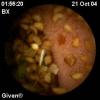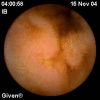Findings in patients with chronic intestinal dysmotility investigated by capsule endoscopy
- PMID: 17640373
- PMCID: PMC1940016
- DOI: 10.1186/1471-230X-7-29
Findings in patients with chronic intestinal dysmotility investigated by capsule endoscopy
Abstract
Background: Capsule endoscopy (CE) is a unique tool to visualize the mucosa of the small intestine. Chronic intestinal dysmotility (CID) is a group of rare disorders of gastrointestinal motility that often are complicated by bacterial overgrowth. The aim of this study was to determine the prevalence of small bowel mucosal abnormalities in patients with CID. We also studied the usefulness of CE in the diagnosis of intestinal dysmotility.
Methods: We conducted a prospective study using CE in 18 patients; six with myopathic, 11 with neuropathic and one with indeterminate CID. A control group was used for comparison of small bowel transit.
Results: Mucosal breaks (erosions and ulcerations) were found in 16/18 (89%) patients. The capsule reached the caecum in 11/18 (61%) patients with a median transit time of 346 minutes. In the control group the capsule reached the caecum in 29/36 (81%) cases with a median transit time of 241 minutes. The difference in transit time was not significant (p = 0.061) in this material. The capsule was retained in the stomach in 3/18 patients. None of the patients developed symptoms or signs of mechanical obstruction.
Conclusion: A high frequency of mucosal breaks and signs of motility disturbances were seen in CID patients. CE is feasible for the examination of small bowel mucosa in patients with CID. The relevance of observed mucosal abnormalities in CID remains uncertain.
Figures
Similar articles
-
Proximal predominance of small bowel injury associated with uncoated low-dose aspirin therapy: a video capsule study in chronic users.Eur J Gastroenterol Hepatol. 2013 Nov;25(11):1265-72. doi: 10.1097/MEG.0b013e3283640fad. Eur J Gastroenterol Hepatol. 2013. PMID: 23873021
-
Sequential capsule endoscopy of the small bowel for follow-up of patients with known Crohn's disease.J Crohns Colitis. 2014 Dec;8(12):1616-23. doi: 10.1016/j.crohns.2014.03.003. Epub 2014 Mar 22. J Crohns Colitis. 2014. PMID: 24666976
-
A prospective evaluation of the diagnostic value of video capsule endoscopy in patients initially classified as irritable bowel syndrome.Eur J Intern Med. 2009 Jan;20(1):48-52. doi: 10.1016/j.ejim.2008.04.018. Epub 2008 Jun 10. Eur J Intern Med. 2009. PMID: 19237092 Clinical Trial.
-
Small bowel mucosal damage in familial Mediterranean fever: results of capsule endoscopy screening.Scand J Gastroenterol. 2014 Dec;49(12):1414-8. doi: 10.3109/00365521.2014.976838. Epub 2014 Nov 5. Scand J Gastroenterol. 2014. PMID: 25369738
-
A Review of Potential Role of Capsule Endoscopy in the Work-Up for Chemotherapy-Induced Diarrhea.Healthcare (Basel). 2022 Jan 24;10(2):218. doi: 10.3390/healthcare10020218. Healthcare (Basel). 2022. PMID: 35206833 Free PMC article. Review.
Cited by
-
Abdominal surgery affects small bowel transit time and completeness of capsule endoscopy.Dig Dis Sci. 2009 May;54(5):1066-70. doi: 10.1007/s10620-008-0467-8. Epub 2008 Aug 22. Dig Dis Sci. 2009. PMID: 18719999
-
Dysmotility and proton pump inhibitor use are independent risk factors for small intestinal bacterial and/or fungal overgrowth.Aliment Pharmacol Ther. 2013 Jun;37(11):1103-11. doi: 10.1111/apt.12304. Epub 2013 Apr 10. Aliment Pharmacol Ther. 2013. PMID: 23574267 Free PMC article.
-
Small intestinal bacterial overgrowth syndrome.World J Gastroenterol. 2010 Jun 28;16(24):2978-90. doi: 10.3748/wjg.v16.i24.2978. World J Gastroenterol. 2010. PMID: 20572300 Free PMC article. Review.
-
Small intestinal bacterial overgrowth as a cause of protracted wound healing and vitamin D deficiency in a spinal cord injured patient with a sacral pressure sore: a case report.BMC Gastroenterol. 2020 Aug 24;20(1):283. doi: 10.1186/s12876-020-01423-8. BMC Gastroenterol. 2020. PMID: 32831031 Free PMC article.
-
Small Intestinal Bacterial Overgrowth: Clinical Features and Therapeutic Management.Clin Transl Gastroenterol. 2019 Oct;10(10):e00078. doi: 10.14309/ctg.0000000000000078. Clin Transl Gastroenterol. 2019. PMID: 31584459 Free PMC article. Review.
References
-
- Christensen J, Dent J, Malagelada JR, Wingate DL. Pseudo-obstruction. Gastroenterol Intl. 1990;3:107–119.
Publication types
MeSH terms
LinkOut - more resources
Full Text Sources



